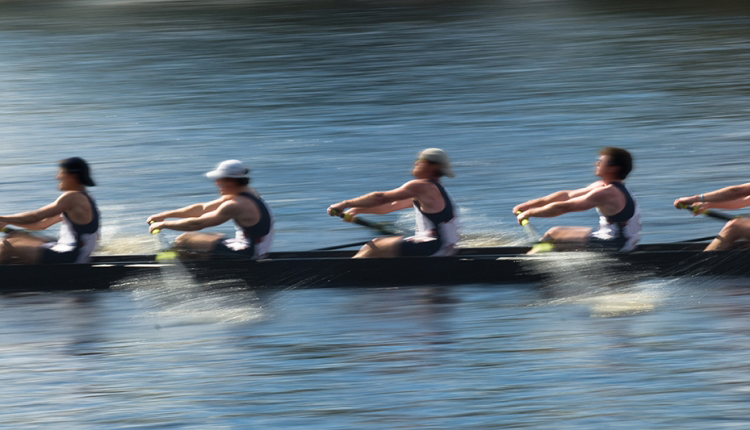
Paul Savell does not miss the irony of his having never competed in the Dad Vail while a rower at the University of Wisconsin, even though the nation’s largest collegiate rowing competition is named for a former Badgers coach.
The Drexel men’s and women’s crew coach may not have enjoyed that opportunity while a member of the UW eight, but he has certainly had more than enough experience with the regatta while leading the Dragon program. From 2013-16, Drexel won the Dad Vail overall title. In ’13 and ’15, Savell’s men won the men’s title, and last May, they took the women’s crown for the first time. Last year, the Dragons became the first school in more than a decade to win the men’s and women’s heavyweight eight competitions. DU has won 62 Dad Vail medals, and Savell’s charges have captured 40 of them.

Drexel crew coach Paul Savell
He may not have been able to row in the regatta, but Savell has had his share of success. And he is delighted to play a sizeable role in the area’s rowing community.
“Philadelphia is the rowing mecca,” says Savell, who rowed at Absecon’s Holy Spirit HS. “It’s such a great rowing community. Boathouse Row is nice to look at, but it’s better to be part of it and to get to know people on the river.”
This May 11-12, the Dad Vail will celebrate its 80th birthday as the largest collegiate regatta in the country. More than 100 teams from the U.S. and Canada will participate over two days in men’s and women’s events that, for many, will be their final competition of the season. Unlike many NCAA races, which are segregated according to institution, the Dad Vail has classes for all college sizes, creating a festival atmosphere that celebrates rowing, rather than merely seeking to crown champions. Make no mistake: the rowers want to win. But this is a chance for the rowing community to display itself.
Thousands of spectators will line the Schuylkill River, and a tent city will spring forth, offering hospitality for fans, refuge for rowers and entertainment for sponsors. Parking headaches will abound, and traffic snarls will enrage drivers as the city’s rowing culture puts forth its brightest face.
“It’s a rite of passage each spring,” says Regatta president Jim Hanna. “Many legends of rowing began their careers at the Dad Vail and then moved on to the Olympics or Henley.”
In the 1930s, then-Penn crew coach Rusty Callow wanted to increase interest and participation in the sport, at a time when many colleges did not offer the opportunity to row or were trying to establish fledgling programs. In ’34, he launched a competition designed to spur involvement in the sport and named the trophy given to the best team for his friend Harry Emerson “Dad” Vail, the former coach at Wisconsin, who had died six years earlier.
Vail had been born in Canada and was at one point a professional sculler. He was known for his warm sense of humor, occasional sarcasm, deep religious beliefs (he would not allow his teams to compete on Sundays) and commitment to the sport. Four years after Callow established the Dad Vail trophy, the Regatta was born.
“This remains one of the premiere rowing experiences any rower can have in the United States,” Hanna says.
The Dad Vail’s Schuylkill home is known as a “rowing river”, since no ships or commercial vessels travel its waters, making it a perfect home to human-propelled crafts of every kind. Its mix of curious currents, wind patterns and tidal flows make it particularly challenging, as does its signature characteristic: a bend in the middle of the 2000-meter course. (High school crews race on a 1,500-meter version, which is a straight shot.)
No college rower will find that kind of challenge on an NCAA championship course, but he or she would face it at Henley. Not that rowing in the Dad Vail has the same cachet as the legendary English competition, but it’s another thing that makes the Regatta unique. Rowers have the opportunity to compete in an environment that has its own personality, in front of crowds they rarely encounter and as part of a tradition that extends back further than many collegiate programs. It’s something that is uniquely Philadelphia and certainly worth experiencing.
“The Dad Vail is the biggest regatta,” Savell says. “It may not be the absolutely highest level of college rowing, because the NCAA championships has faster boats. But in terms of history and the teams that keep coming back, it’s special.”
John Strotbeck has been a member of the Vesper Boathouse since 1981 and was part of two winning Dad Vail boats during his time at Marietta College. He rowed for the U.S. in the 1984 and ’88 Olympics, and his Boathouse apparel company has been a sponsor of U.S. rowing for nearly a decade. He has seen plenty on the water and understands the importance of the Dad Vail.
“It’s a tremendous regatta,” Strotbeck says. “When I rowed in the ‘70s and ‘80s, five-to-10 times the number of people showed up. But it is still a great spectacle.”
When Saint Joseph’s women’s basketball team holds a practice, it allows precious few people to watch. Perhaps a handful of high school coaches gain admittance. A stray media member could wander in. The proceedings are largely top-secret. Walk in uninvited, and you will most likely be asked to leave—quickly.
But when Gerry Quinlan’s SJU women’s crew boats take to the Schuylkill, there are no such precautions. In fact, the Hawk rowers could be practicing right next to teams against whom they will be competing at the Dad Vail and other races throughout the season. If Quinlan wants his boats to work on something new or try a changeup, it has to happen in full public view.
“People don’t realize how many people are on the river every day,” Quinlan says. “There are a couple thousand people. Our team has 110 members alone.”
And anybody on the river had better be alert. There’s always another boat close by, and the fastest crafts get the right of way.
“There’s a rule that’s been in place for over a century on the Schuylkill,” Strotbeck says. “If you are being overtaken by another crew, get the hell out of the way.”
That’s rowing in Philadelphia. In addition to Quinlan’s Hawks and the other college outfits on the river, there are high school teams, elite international competitors, club rowers, masters’ participants and just people out there for a demanding workout. People make fun of the Schuylkill for its name, its color at times (brown water?) and the dastardly expressway to which it lends its name. But rowers love the waterway, and they show that devotion by spending considerable time on it.
Though there are some occasional problems that creep up, like some excess milfoil (dense, aquatic plants) in lane six that Hanna says needs to be removed to prevent it from clogging the pathway for boats, the Schuylkill is the perfect playground for crews of all abilities. A big reason for that is the Schuylkill Navy, which helps keep the rowing community alive. Under the direction of Commodore Paul Horvat, the Navy brings together the disparate personalities contained within the 12 main boathouses (there are other houses further west on the river) by promoting and regulating the sport. The result is a camaraderie that transcends the competition and creates an ethos that can’t be replicated by other sport. Because rowers often toil in complete anonymity, thanks to the odd juxtaposition found when the demands of individual training meet the tyranny of the team, they forge bonds that are stronger than those found in other sports. Just about everybody plays basketball. Only a small percentage of people choose to pull an oar. In Philadelphia, that connection is as tight as anywhere else in the country.
“Philadelphia is one of the premiere rowing centers in the United States,” Strotbeck says. “It has been that way consistently since the early 1900s.”
Dozens of Dad Vail alumni have gone on to row at Henley and in the Olympics. And any day on the river can feature elite competitors honing their skills and endurance for future international competition. Mix in a menagerie of other rowers, and you have a rare athletic blend that can’t be found elsewhere. The Dad Vail sits as the centerpiece on a waterway that defines a unique Philadelphia sporting culture.
“On a three-mile stretch of river, you have 12 boathouses in close proximity that both on and off the water allows athletes to push each other,” Strotbeck says. “It’s one of the advantages of rowing in Philadelphia.”
And competing in the Dad Vail.

